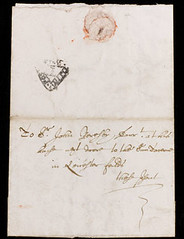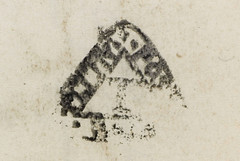
PREV ARTICLE
NEXT ARTICLE
FULL ISSUE
PREV FULL ISSUE
ONE OF WORLD'S FIRST POSTAL STAMPS OFFERED BY SOTHEBY'S
Communication revolutions are nothing new. Long before the Internet there was the London Penny Post, which changed the world in 1680 much the same way as the Internet did in the 1990s. This is a non-numismatic article, but a stamp of this importance deserves a mention.
-Editor
For an up-front fee of 1d, the system guaranteed delivery of a letter anywhere in London and its immediate environs within four hours. Original Dockwra stamps are exceptionally rare �" only one other “Murray” stamp is recorded in private hands (the rest are in institutional collections). The stamp offered for sale (estimated at �£15,000-20,000) is printed on a letter sent by William Farmerie, a lawyer working in Holborn, to the politician Sir John Reresby at his house in the newly developed area of Leicester Fields (today’s Leicester Square).
Launched by the partnership of “undertakers” William Dockwra and Robert Murray in late March 1680, the services of the penny post were advertised through handbills and in several newspapers. For the fee of a penny (equivalent to roughly 55p today), the undertakers guaranteed delivery of a letter anywhere within the capital and its environs within four hours. Several hundred receiving houses were established where a messenger would call hourly to take all letters received to the closest of the seven sorting offices where they were stamped (at least from December 1680 onwards) and sorted for onward delivery. The sender, recipient and time of posting all letters was recorded in registers, and compensation paid for failure to deliver. The penny post provided an excellent method of disseminating propaganda and it was also independent of the Royal Mail which was controlled by the Duke of York. There is plenty of evidence connecting Dockwra and Murray to Whig circles and as early as the autumn of 1680 the government brought law suits to try and suppress this infringement of its monopoly. In 1682 the Post Master General succeeded in its action and the penny post (owned at this date by Dockwra, after the partnership with Murray collapsed) was taken over by the government. The government continued to run the system virtually unchanged for the next 100 years.
To read the complete article, see:
Sotheby's London to sell rare, newly discovered 1680 stamp - a communication revolution
(www.artdaily.org/index.asp?int_sec=2&int_new=51181)
The Numismatic Bibliomania Society is a non-profit organization promoting numismatic literature. See our web site at coinbooks.org. To submit items for publication in The E-Sylum, write to the Editor at this address: whomren@gmail.com To subscribe go to: https://my.binhost.com/lists/listinfo/esylum All Rights Reserved. NBS Home Page Contact the NBS webmaster 
|

